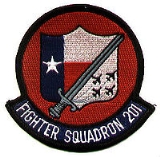
VFA-201
Encyclopedia
The VFA-201, Strike Fighter Squadron was an aviation unit of the United States Naval Reserve based at Naval Air Station Joint Reserve Base Fort Worth
, Texas (USA)
. It was established in 1970 as part of Reserve Carrier Air Wing 20 (CVWR-20)
and disestablished in 2007. During its service VFA-201 could be identified by the tail code "AF-1XX" and their nickname is Hunters.
on 25 July 1970, succeeding VF-124D1. It first flew the Vought F-8H Crusader
, and in 1976 it transitioned to the McDonnell Douglas F-4N Phantom II
. In 1984 the squadron transitioned to the F-4S, the most advanced Phantom to enter service with the United States Navy
. Soon the U.S. Navy moved to the policy that reserve units would have the same equipment as front line units, VF-201 transitioned to the Grumman F-14A Tomcat
in early 1987 and was the last Navy squadron to fly F-4's. It took six months to complete the transition and soon VF-201 was carrier qualified on board the aircraft carrier . Even some of the F-14As received came directly from the production line at Grumman
, and the unit received the final F-14A ever built. Within years the squadron was capable of dropping unguided bombs, cluster munitions TALD decoys, air laid mines, practice bombs, marker flares and various laser guided bombs as the F-14 was reconfigured as a strike fighter. In 1993 they won the Battle “E” award and in 1994 the Chief of Naval Operations (CNO) Safety “S” award. The strike capability of the F-14 has been proven in exercises such as the deployment the squadron made to NAS Fallon in 1995 as part of training for the reserve air wing CVWR-20.
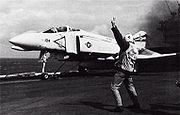
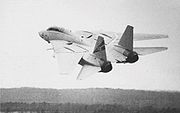
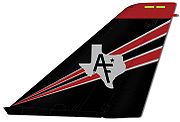
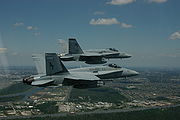 Later the unit would also be able to conduct TARPS reconnaissance missions, which were originally carried out by VF-202
Later the unit would also be able to conduct TARPS reconnaissance missions, which were originally carried out by VF-202
. But as some front line F-14 squadrons saw disestablishment during the 1990s, so did the two reserve fighter squadrons and VF-202 was disestablished. Due to budgetary cutbacks in active fleet aggressor squadrons, VF-201 also began flying as aggressors when needed. In 1996 VF-201, along with the rest of RCVW-20, deployed on the , during this deployment VF-201 had the opportunity to fire live weapons. The unit fired 7 AIM-9 Sidewinder
s, 6 AIM-7 Sparrow
s and 1 AIM-54 Phoenix
, two additional Phoenix missiles were planned to be fired but due to technical difficulties this was aborted. VF-201 also dropped 17,000 lb of bombs.
In July 1996 VF-201 deployed to NAS Key West in Florida to provide dissimilar air training for VFA-106
Gladiators, the U.S. East Coast F/A-18 training squadron. In August and September the same year, VF-201 deployed to NAS Oceana and got to fire two Phoenix missiles as well as participating in the SFARP (Strike Fighter Air Readiness Program) course. In November 1996 VF-201 deployed to NAS Fallon where they provided Dissimilar Air Combat Training (DACT) for Carrier Air Wing Two
. After this deployment to NAS Fallon, VF-201 moved to NAS Fort Worth.
In 1997 the Hunters deployed for three days with six aircraft to Elmendorf AFB, Alaska
for Exercise "Arctic Express 1-97". Originally this deployment had been scheduled for an active F-14 squadron, but they were unable to attend and so VF-201 filled the slot. Less than two weeks later. In late January, VF-201 took part in a scheduled deployment to NAS Fallon and the squadron dropped 195,000 lb of ordnance and shoot 3500 rounds of 20 mm cannon ammo. In March, VF-201 deployed to NAS Key West for a two week detachment providing training to new F-14 crews from VF-101
.
In January 1999 the Hunters transitioned to the McDonnell Douglas F/A-18A Hornet
, because the F-14 Tomcat was out of production and the Navy wanted the ones the Reserves were using, and were re-designated VFA-201 to signify its multi-mission capability as a strike fighter squadron.
Some of their deployments included:
Carrier detachments:
USS Dwight D. Eisenhower,
USS John F. Kennedy,
USS Kitty Hawk, and the
USS John C. Stennis.
Tours of Duty locations:
Roosevelt Roads, Puerto Rico,
Sigonella Airbase, Sicily,
Key West NAS, FL.,
Fallon, NV.,
Oceana, VA.,
Point Magu, CA., and
Eglin AFB, FL.
coordinated strike detachment in Fallon, Nevada, they deployed on board from 6 January to 29 May 2003, where they received numerous awards for their performance over Iraq during the first phases of Operation Iraqi Freedom. In fact, the squadron delivered over 220,000 pounds of ordnance on Iraq targets. Additionally, VFA-201 had an unprecedented 84.6 target acquisition rate during Iraqi Freedom and won the Carrier Air Wing Eight landing grade competition for their entire workup and combat deployment.
Naval Air Station Joint Reserve Base Fort Worth
Naval Air Station Fort Worth Joint Reserve Base or NAS Fort Worth JRB includes Carswell Field, a military airfield located west of the central business district of Fort Worth, in Tarrant County, Texas, United States. This military airfield is operated by United States Navy...
, Texas (USA)
Texas
Texas is the second largest U.S. state by both area and population, and the largest state by area in the contiguous United States.The name, based on the Caddo word "Tejas" meaning "friends" or "allies", was applied by the Spanish to the Caddo themselves and to the region of their settlement in...
. It was established in 1970 as part of Reserve Carrier Air Wing 20 (CVWR-20)
Tactical Support Wing
The Tactical Support Wing is a United States Navy reserve Tactical air wing based at Naval Air Station Joint Reserve Base Fort Worth. Commander, Tactical Support Wing has become the new designation of the former Reserve Carrier Air Wing 20 . This change occurred on 1 April 2007 and was executed...
and disestablished in 2007. During its service VFA-201 could be identified by the tail code "AF-1XX" and their nickname is Hunters.
History
The United States Naval Reserve fighter squadron VF-201 was established at NAS DallasNaval Air Station Dallas
Naval Air Station Dallas was a United States Navy Naval Air Station located on Mountain Creek Lake in southwest Dallas. The installation was originally established as an Army Aviation center, and eventually became home to aviation assets from all the military services. The facility was...
on 25 July 1970, succeeding VF-124D1. It first flew the Vought F-8H Crusader
F-8 Crusader
The Vought F-8 Crusader was a single-engine, supersonic, carrier-based air superiority jet aircraft built by Vought for the United States Navy and the U.S. Marine Corps, replacing the Vought F7U Cutlass...
, and in 1976 it transitioned to the McDonnell Douglas F-4N Phantom II
F-4 Phantom II
The McDonnell Douglas F-4 Phantom II is a tandem two-seat, twin-engined, all-weather, long-range supersonic jet interceptor fighter/fighter-bomber originally developed for the United States Navy by McDonnell Aircraft. It first entered service in 1960 with the U.S. Navy. Proving highly adaptable,...
. In 1984 the squadron transitioned to the F-4S, the most advanced Phantom to enter service with the United States Navy
United States Navy
The United States Navy is the naval warfare service branch of the United States Armed Forces and one of the seven uniformed services of the United States. The U.S. Navy is the largest in the world; its battle fleet tonnage is greater than that of the next 13 largest navies combined. The U.S...
. Soon the U.S. Navy moved to the policy that reserve units would have the same equipment as front line units, VF-201 transitioned to the Grumman F-14A Tomcat
F-14 Tomcat
The Grumman F-14 Tomcat is a supersonic, twin-engine, two-seat, variable-sweep wing fighter aircraft. The Tomcat was developed for the United States Navy's Naval Fighter Experimental program following the collapse of the F-111B project...
in early 1987 and was the last Navy squadron to fly F-4's. It took six months to complete the transition and soon VF-201 was carrier qualified on board the aircraft carrier . Even some of the F-14As received came directly from the production line at Grumman
Northrop Grumman
Northrop Grumman Corporation is an American global aerospace and defense technology company formed by the 1994 purchase of Grumman by Northrop. The company was the fourth-largest defense contractor in the world as of 2010, and the largest builder of naval vessels. Northrop Grumman employs over...
, and the unit received the final F-14A ever built. Within years the squadron was capable of dropping unguided bombs, cluster munitions TALD decoys, air laid mines, practice bombs, marker flares and various laser guided bombs as the F-14 was reconfigured as a strike fighter. In 1993 they won the Battle “E” award and in 1994 the Chief of Naval Operations (CNO) Safety “S” award. The strike capability of the F-14 has been proven in exercises such as the deployment the squadron made to NAS Fallon in 1995 as part of training for the reserve air wing CVWR-20.




VF-202
The Fighter Squadron VF-202 Superheats was an aviation unit of the United States Naval Reserve based at Naval Air Station Dallas, Texas . It was established in 1970 as part of Reserve Carrier Air Wing 20 and disestablished in 1994...
. But as some front line F-14 squadrons saw disestablishment during the 1990s, so did the two reserve fighter squadrons and VF-202 was disestablished. Due to budgetary cutbacks in active fleet aggressor squadrons, VF-201 also began flying as aggressors when needed. In 1996 VF-201, along with the rest of RCVW-20, deployed on the , during this deployment VF-201 had the opportunity to fire live weapons. The unit fired 7 AIM-9 Sidewinder
AIM-9 Sidewinder
The AIM-9 Sidewinder is a heat-seeking, short-range, air-to-air missile carried mostly by fighter aircraft and recently, certain gunship helicopters. The missile entered service with United States Air Force in the early 1950s, and variants and upgrades remain in active service with many air forces...
s, 6 AIM-7 Sparrow
AIM-7 Sparrow
The AIM-7 Sparrow is an American, medium-range semi-active radar homing air-to-air missile operated by the United States Air Force, United States Navy and United States Marine Corps, as well as various allied air forces and navies. Sparrow and its derivatives were the West's principal beyond visual...
s and 1 AIM-54 Phoenix
AIM-54 Phoenix
The AIM-54 Phoenix is a radar-guided, long-range air-to-air missile , carried in clusters of up to six missiles on F-14 Tomcats, its only launch platform. The Phoenix was the United States' only long-range air-to-air missile. The weapons system based on Phoenix was the world's first to allow...
, two additional Phoenix missiles were planned to be fired but due to technical difficulties this was aborted. VF-201 also dropped 17,000 lb of bombs.
In July 1996 VF-201 deployed to NAS Key West in Florida to provide dissimilar air training for VFA-106
VFA-106
Strike Fighter Squadron 106 , also known as the "Gladiators," is a United States Navy F/A-18 Hornet and F/A-18 Super Hornet Fleet Replacement Squadron stationed at Naval Air Station Oceana, Virginia.-Mission:...
Gladiators, the U.S. East Coast F/A-18 training squadron. In August and September the same year, VF-201 deployed to NAS Oceana and got to fire two Phoenix missiles as well as participating in the SFARP (Strike Fighter Air Readiness Program) course. In November 1996 VF-201 deployed to NAS Fallon where they provided Dissimilar Air Combat Training (DACT) for Carrier Air Wing Two
Carrier Air Wing Two
Carrier Air Wing Two is a United States Navy aircraft carrier air wing based at Naval Air Station Lemoore. The air wing is attached to the aircraft carrier USS Abraham Lincoln .-Mission:...
. After this deployment to NAS Fallon, VF-201 moved to NAS Fort Worth.
In 1997 the Hunters deployed for three days with six aircraft to Elmendorf AFB, Alaska
Alaska
Alaska is the largest state in the United States by area. It is situated in the northwest extremity of the North American continent, with Canada to the east, the Arctic Ocean to the north, and the Pacific Ocean to the west and south, with Russia further west across the Bering Strait...
for Exercise "Arctic Express 1-97". Originally this deployment had been scheduled for an active F-14 squadron, but they were unable to attend and so VF-201 filled the slot. Less than two weeks later. In late January, VF-201 took part in a scheduled deployment to NAS Fallon and the squadron dropped 195,000 lb of ordnance and shoot 3500 rounds of 20 mm cannon ammo. In March, VF-201 deployed to NAS Key West for a two week detachment providing training to new F-14 crews from VF-101
VF-101
Fighter Squadron 101, also known as VF-101 and the Grim Reapers, was a United States Navy F-14 Fleet Replacement Squadron based at Naval Air Station Oceana until disestablishment in 2005...
.
In January 1999 the Hunters transitioned to the McDonnell Douglas F/A-18A Hornet
F/A-18 Hornet
The McDonnell Douglas F/A-18 Hornet is a supersonic, all-weather carrier-capable multirole fighter jet, designed to dogfight and attack ground targets . Designed by McDonnell Douglas and Northrop, the F/A-18 was derived from the latter's YF-17 in the 1970s for use by the United States Navy and...
, because the F-14 Tomcat was out of production and the Navy wanted the ones the Reserves were using, and were re-designated VFA-201 to signify its multi-mission capability as a strike fighter squadron.
Some of their deployments included:
Carrier detachments:
USS Dwight D. Eisenhower,
USS John F. Kennedy,
USS Kitty Hawk, and the
USS John C. Stennis.
Tours of Duty locations:
Roosevelt Roads, Puerto Rico,
Sigonella Airbase, Sicily,
Key West NAS, FL.,
Fallon, NV.,
Oceana, VA.,
Point Magu, CA., and
Eglin AFB, FL.
2003 combat deployment
VFA-201 was the seventh tactical Navy reserve squadron mobilized since the Korean War (three East Coast based and three West Coast based USNR squadrons were activated during the Vietnam war on 28 January 1968), but were the only squadron to actually deploy for combat operations. After completing the Strike Fighter Advanced Readiness Program (SFARP) from their home base in Fort Worth and the Carrier Air Wing EightCarrier Air Wing Eight
Carrier Air Wing Eight , is a United States Navy aircraft carrier air wing based at Naval Air Station Oceana, Virginia. The air wing is attached to the aircraft carrier USS George H.W...
coordinated strike detachment in Fallon, Nevada, they deployed on board from 6 January to 29 May 2003, where they received numerous awards for their performance over Iraq during the first phases of Operation Iraqi Freedom. In fact, the squadron delivered over 220,000 pounds of ordnance on Iraq targets. Additionally, VFA-201 had an unprecedented 84.6 target acquisition rate during Iraqi Freedom and won the Carrier Air Wing Eight landing grade competition for their entire workup and combat deployment.
Decommissioning
VFA-201 was officially deactivated on 30 June 2007, and all hardware assets transferred to their sister squadron, VFA-204, or other active duty Navy and Marine Corps units.See also
- History of the United States NavyHistory of the United States NavyThe history of the United States Navy divides into two major periods: the "Old Navy", a small but respected force of sailing ships that was also notable for innovation in the use of ironclads during the American Civil War, and the "New Navy", the result of a modernization effort that began in the...
- List of inactive United States Navy aircraft squadrons
- List of United States Navy aircraft squadrons

